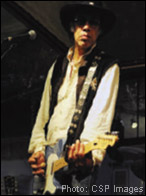 What is the slide guitar? Some guitars are specially made for slide, with raised strings, but it can actually be any guitar, where some or all of the fretting is accomplished by applying a smooth surface like a knife blade or the neck of a glass bottle to the strings. It can be done in standard tuning or various special tunings. Certain serious-minded types have written whole books on the slide guitar, coming to various conclusions about where it started, who did it first, Hawaiian slack key guitar, the diddley bow, whatever. The truth is nobody will ever know. I cannot imagine gypsies not having tried it four hundred years ago.
What is the slide guitar? Some guitars are specially made for slide, with raised strings, but it can actually be any guitar, where some or all of the fretting is accomplished by applying a smooth surface like a knife blade or the neck of a glass bottle to the strings. It can be done in standard tuning or various special tunings. Certain serious-minded types have written whole books on the slide guitar, coming to various conclusions about where it started, who did it first, Hawaiian slack key guitar, the diddley bow, whatever. The truth is nobody will ever know. I cannot imagine gypsies not having tried it four hundred years ago.
All I know is when I first tried it, about four hundred years ago, it threw me. I guess it was too simple, I couldn’t imagine getting those sounds out of THIS. But as I wrestled with it I began to understand. This was the Crossroads, and here was the alchemical riddle unfurled.
Of course, as a good Washington Square boy I had been playing in tunings for years, but the slide puts you right out front, people expect skills if you’re gonna brag. I remember the moment I realized I had it, I was sitting alone in a bare little office wearing a cheap suit. Don’t ask. I had a still-wet whiskey glass on my pinky, a cheap old classical guitar on my knee, the blues in my heart and a “Hellhound on My Trail.” I felt like I had found the Philosopher’s Stone. Got out of that office and never worked in another.
There is a story those serious-minded guys like to tell, about W.C. Handy waiting for a train at Tutwiler, Mississippi in 1903. According to W.C., a “lean, loose-jointed Negro had commenced plucking a guitar beside me while I slept. As he played, he pressed a knife on the strings of a guitar…The effect was unforgettable. His song, too, struck me instantly. ‘Goin’ where the Southern cross’ the Dog’…The singer repeated the line three times, accompanying himself on the guitar with the weirdest music I had ever heard…” and thus the blues came to the world at large.
But who was the fellow with the guitar? We will never know, but we might know his name. Let’s indulge the imagination: if 1903 is too early for Charley Patton, might it have been Ike Zinnerman? Like Buddy Bolden, he influenced everyone, but left us no extant recording.
And here, then, is a truth: the slide guitar, like the blues itself, is a child of the phonograph and the radio. It foretells the advent of the electric guitar, with its gliss, its metallic timbre, its weirdness. The slide-driven resonator guitar contains within its sound the entire dream of the electric age, jet engines, rockets in space, all the pain and delight of alien sensualities. And perhaps that’s the magic. This undeniably modern sound, coming out of an antique context—the music is almost a hundred years old in some cases—timelessly speaks of our hopes and fears, humor and delight, and sometimes abject terror.
—Robin the Hammer



Be the first to comment!